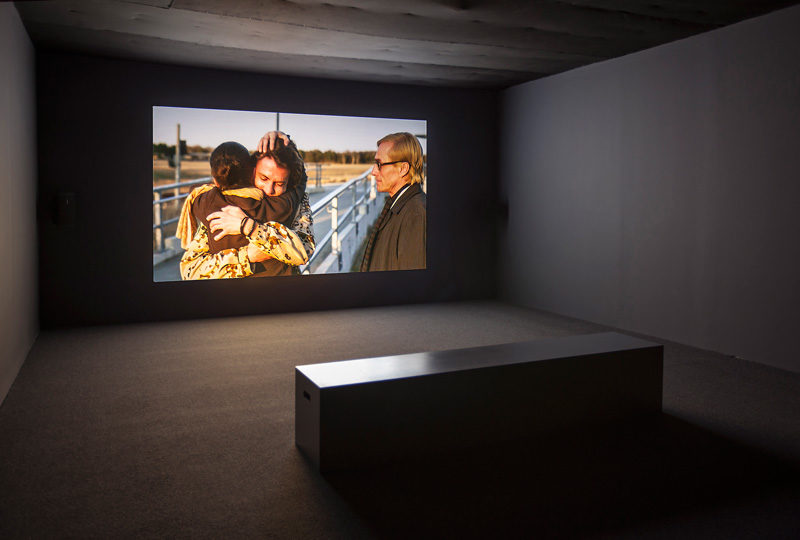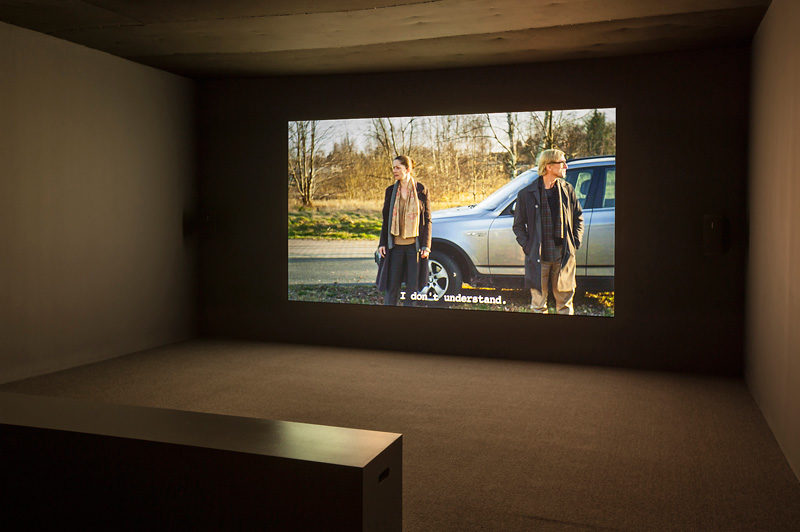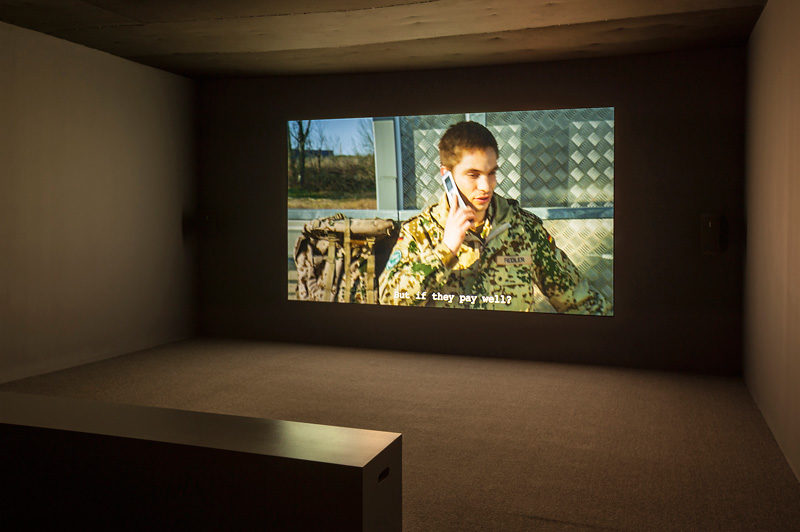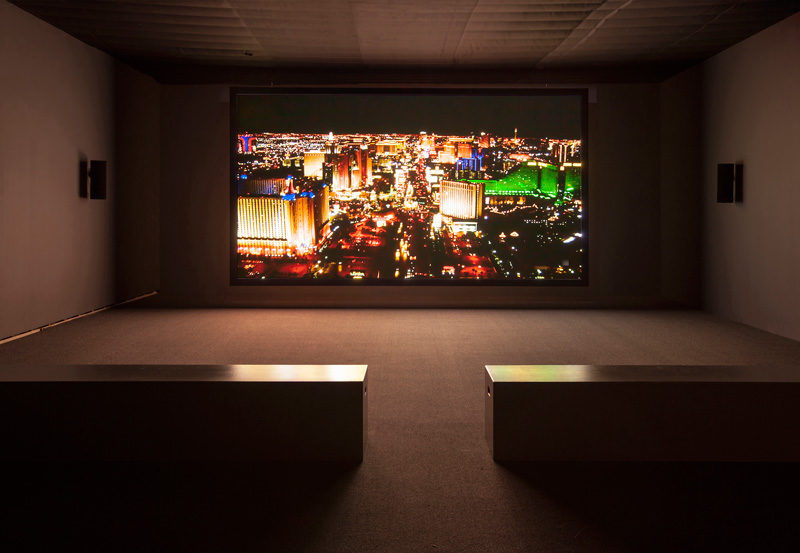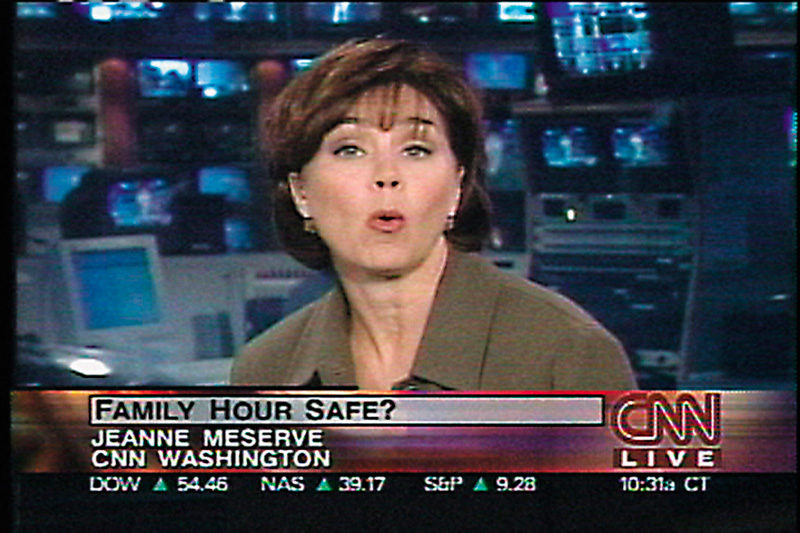[Spring-Summer 2013]
Omer Fast is not a documentarian, but his recent solo exhibition at The Power Plant Contemporary Art Gallery did draw attention to the strategies of an artist working, as Jeff Wall put it, “near documentary.”1 Spanning the last decade, the exhibition referenced sites of recent global conflict with three video works that quoted documentary or journalistic conventions only to subvert the anticipated veracity and assumed authority of these forms with looped narratives, traumatic repetitions, and the comically stilted utterances of what was once the “continuous coverage” of cable news.
CNN Concatenated (2002), produced in the aftermath of 9/11, is the earliest work in the exhibition, and the one in which Fast is most explicit about showing his hand. Working from a ten-thousand-word transcript of television news reports, Fast edited clips of CNN “talking heads” into single-word utterances. As an artist, Fast knows that form can be detached from content, and that meaning can be radically altered when the content of news reporting is separated from the form of the news broadcast. Halting televisual flow and re-editing single words from the barrage of non-stop news gives viewers pause from the assumed truth-telling power of the media. In this regard, it is interesting to consider the language of news reporting, and specifically the role of the news anchor. “Anchors” deliver information objectively, and they are therefore thought to anchor the truth, making them authority figures. In Fast’s project, words are cut loose from their source, de-anchored, so as to subvert the truth and authority of the official text and its agent. In the stilted phraseology of news-speak, alternative voices emerge from within the text, rewriting external events into a stream of consciousness of dissociative thoughts. To whom are these voices addressed and how does the factual voice of the news devolve into a combination of side jokes, accusations, and expressions of post–9/11 anxiety? At one point, for example, the voice inside the text iterates what might be a methodological strategy for contemporary art generally or a self-reflexive confession for Fast specifically: “It-is-so-difficult-for-you-to-believe-in-anything-without-looking-for-its-potential-to-destabilize.” As much as CNN Concatenated is a work about words, it is also about the space between words and the pauses in an utterance that give way to anticipation of what comes next. And of course, anxiety over what comes next was very much on the mind of the post–9/11 world. Through recognizable images of disaster that refresh the screen and the broken speech and the disquieting pauses of a reordered narrative, Fast elicits anxious affects in the viewer to parallel an anxious time.
Five Thousand Feet is the Best (2011) is a video work drawn from interviews that Fast conducted with an American Predator drone pilot. What connects the work discussed above and this video is the use of television screens or monitors as an intermediary device between the viewer and reality. Fundamentally different, however, are the deadly consequences that attend to the drone operator’s screen. On-camera, the drone operator was willing to discuss the technical aspects of his job. Off-camera, he divulged the psychological struggles that have resulted from the remote killing of both militants and civilians and the bad dreams and “virtual stress” that he suffers as a result of PTSD. Drones are an increasingly significant component of high-tech war.2 Fast draws our attention to this important issue and points to the disjunctive psychological and geopolitical relations that connect a military base, one hour away from Las Vegas, Nevada, where American drone pilots are based, to locations in Pakistan, Yemen, and Afghanistan, from where drone attacks are launched.
In this piece, parallel stories that oscillate between real and fictive scenarios are repeated in a looped or circular structure. Interviews between a fictional drone pilot and a fictional journalist are repeated in almost verbatim exchanges on three occasions, and the testimony of the real drone pilot is intercut between these scenes. The video loop is by now a gallery standard, as it provides multiple entry and exit points for viewers attending an exhibition. However, more than a logistical form, the looped narrative is an integral component of Fast’s work, as he is reordering time and offering us an opportunity to replay key sequences, critically re-examine our own memory of the events represented in the video, and reflect on our understanding of what is real and what is not.
To protect the real drone pilot’s anonymity, his voice has been mechanically altered, his face has been blurred, and he speaks offcamera in voice-over. The use of the voice-over and the purposely blurred rendition of the face is a technique well established in investigative journalism and expository documentary. As viewers, we recognized that these techniques announce the presence of the real. However, the off-camera voice-over, the so-called voice of God, is often met with derision by progressive documentary makers as it is aligned with power, authority, stereotypical masculinity, and anonymity. Kaja Silverman suggests that in Hollywood films, “the male subject finds his most ideal realization when he is heard but not seen.”3 Although not a Hollywood or documentary film but a critical work of art, Fast’s piece aligns the voice on high with an eye in the sky and a pervasive, if invisible, militaristic presence.
The drone pilot’s reflections on drone warfare and the targeting of enemy insurgents in Pakistan are accompanied by beautiful Steadicam airborne sweeps over the shimmering lights of the nightclub strip in Las Vegas at night, daylight views of a churchyard in the northeastern United States, and scenes of suburban Las Vegas. Fast turns the tables on expectations by replacing drone surveillance of foreign lands with domestic views in these near-documentary encounters. As counterpoint, the fictional pilot tells a story of an American family going on vacation: they pass three stereotypically “redneck” American men digging along a desert road. One is described as wearing “a traditional headdress” (a baseball hat) and the other two are described as being “dressed in clothes more typical to tribes from further south.” A drone transmits the scene from above as a Hellfire missile “hits the ground before anyone can react.” In this exchange, the landscapes of Pakistan and Nevada blur together, as do the roles of victims and perpetrators. The voice-over concludes, “Seeing the world from above doesn’t just flatten things, it sharpens them, it makes relationships clearer.” In these acts of juxtaposition, both realistic and overtly fictional, Fast reminds us that militarization is not something that happens in war zones unconnected to our lives but that under global militarization, as exemplified by drone warfare, relationships between here and there are intractably linked and woven, often invisibly, into the fabric of a now global community. Continuity (2012) was produced for Documenta 13 and is the most recent work in the exhibition. Whereas the other two works play with the relationship between reality and fiction or use documentary forms to cite the real, in this last piece the depiction of reality is all but abandoned. Melodramatic and replete with impeccable production values, the forty-minute piece concerns a contemporary German couple mourning the loss of a son to war. On three occasions, the couple drive to the local train station to greet their son. Although this is explicitly a fictional work, the Bundeswehr German army uniform and the International Security Assistance Force (ISAF) patch worn by a different actor in each version contextualize the act of return in relation to the war in Afghanistan. The family attempt to pick up where they left off and to take their son home and to his bedroom, “untouched since he left.” They sit down to what becomes a most unusual dinner in which weird things enter into the setting: an eyeball bobbles in a glass of wine, maggots crawl within the pasta. Incest darkly permeates the fictional family scene as the figure of the lost son has been replaced by three male stand-ins in military uniforms; they are physically inspected by the father, and the mother erotically kisses one of them and joins another in bed.
In this piece, Fast’s use of the loop takes on psychic dimensions. The scene of the returning son is fraught with the difficult return of trauma. A disturbing repetition ensues in which the return to normality or, as the title suggests, continuity within the family and within reality, is rendered impossible. The narrative loop that results in the couple’s return to the train station to re-enact a scene of family reunification dramatizes trauma’s broken record and the obsessive return to an unresolved experience of loss. With every return to the train station, the dead who are the repressed complement of war pile up, quite literally, in a pit off the road. With what seems to be a clear reference to Jeff Wall’s large-scale compilation photograph Dead Troops Talk (A Vision After an Ambush of a Red Army Patrol near Moqor, Afghanistan, Winter, 1986) (1992), Fast shows us a pit filled with soldiers as a lone Afghani civilian scavenges through the wreckage to retrieve the rifles that the dead will no longer use. That the German couple are led to the pit by a runaway camel marks another uncanny return, as a displaced figure from a site of contemporary conflict in another part of the world slips into the scene and, as Fast has suggested, “Afghanistan and Germany sort of implode.”4 We might read this work as the psychic and overtly fictional follow- up to the geopolitical entanglements signified in Five Thousand Feet is the Best. In each of these two works, zones of contemporary conflict are juxtaposed as the living and the dead intertwine and the nightmarish implications of our global relationships become clearer.
2 In an excellent publication that accompanied this exhibition at The Power Plant Contemporary Art Gallery, David Rohde reports that over the last three years the Obama administration has conducted more than five times the number of covert drone strikes as approved under the George W. Bush administration. See David Rohde, “The Obama Doctrine: How the President’s Drone War is Backfiring,” in Milena Hoegsberg and Melanie O’Brian (eds.), Omer Fast: 5,000 Feet is the Best (Berlin: Sternberg Press, 2012), p. 63.
3 Kaja Silverman, The Acoustic Mirror: The Female Voice in Psychoanalysis and Cinema (Bloomington and Indianapolis: Indiana University Press, 1988), p. 164.
4 Omer Fast, in “Omer Fast and Kris Paulsen: A Conversation,” Wexner Center for the Arts http://wexarts.org/wexblog/?m=201207).
Blake Fitzpatrick is a professor and the graduate program director of the Documentary Media (MFA) program at Ryerson University. He is an active photographer, curator, and writer. His research interests include the photographic representation of the nuclear era, visual responses to contemporary militarism, and images of disaster in contemporary landscape photography. His writing and visual work have appeared in Public, Topia, History of Photography, Fuse Magazine, Geist, and Ciel Variable.

